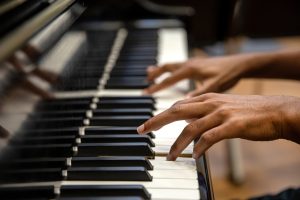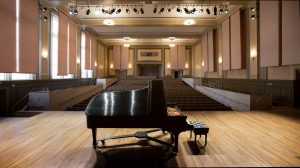
The world is changing dramatically from the COVID-19 pandemic, and many old ways of thinking are being challenged. The flawed system of meritocracy, at the heart of US culture, must be reconsidered. In this system, the aim of so many activities is to assert superiority. Students are expected to outdo each other in order to win scholarships, prizes, and status. The western musical canon is also based on a sort of social Darwinism. Certain composers are presumed to be super-human while others are denied a coveted spot in the pantheon. These values echo a nineteenth-century concept of genius and Nietzsche’s übermensch. In classical music (which itself is an unclear term), these values lead to perfectionism, exemplified by literal interpretations of the score and the disappearance of improvisation. Many say that competition brings out the best in people, but it can also deaden the creative spirit. Racism, sexism, and classism are intertwined with a competitive, hierarchical worldview. What if we began with the assumption that every person has unique, intrinsic value, and consequently, so does every student, every composer, and every work of art. Then, the nature of education would be to elicit and develop the individual’s latent voice, a process akin to gardening or story-telling. The following are suggestions for piano students to develop their individual style. Hardly new ideas, most of these activities were once part of a typical eighteenth-century musical education.
Improvisation
Bach, Chopin, Liszt, Beethoven, and so many other classical composers were masters of improvisation, and their compositions and approach to the keyboard were deeply rooted in it. While jazz and world music are unthinkable without improvisation, classical music has somehow lost this tradition. Students can start with free improvisation, and intersperse their practice sessions with it. Next, they can improvise around strict models, such as figured bass, partimenti, and lead sheets. Improvisation develops an idiomatic approach to the instrument, along with a personal sense of tempo rubato, which was highly regarded in earlier eras (recordings from a hundred years ago demonstrate this). Interpretations rooted in improvisation contain a performer’s individual stamp, their unique fingerprints so to speak. Ultimately, improvisation involves radical self-acceptance and the willingness to make mistakes, steps that can also help build a more compassionate world.
Composition
Compositions are essentially written out improvisations. Writing music will not only engage a student’s personal approach to their instrument (connected to improvisation), it will also lead to a more thorough knowledge and appreciation for the craft of music in general. The first step is to have blank music paper and to just write. As with improvising, students can write free compositions and write in strict forms such as the fugue.
Score reading
The piano is more than just a solo instrument; it is a powerful tool to reimagine music of all kinds. Hans von Bülow could sight read a full orchestral score on the piano, and I believe that every piano student can learn how to do this with practice. Reading and playing orchestral and chamber music scores at the piano is just an extension of general sight reading, which is a “muscle” that students can work on daily.
Playing by ear and transcribing

Playing by ear and transcribing reveals the inner workings of music theory in a powerful way. Students can play along with recordings. Recently in the group piano class, we took a recording of Mississippi John Hurt and played along with it. Transcribing is really a more detailed, written out version of playing by ear. As an example, I am transcribing recordings of Mahalia Jackson for solo piano, whose voice so moved Martin Luther King Jr. that he said a voice like hers only comes about once in a thousand years. Writing these transcriptions is like taking lessons with Jackson, learning the phrasing and musical rhetoric of a great musical communicator. My transcriptions are somewhat based on Liszt’s arrangements of Schubert’s Lieder. Performing one’s own transcriptions was far more commonplace in the past, so this, too, is not a new idea.
Listening
I recommend students listen daily to music that they have never listened to before. For example, they can immerse themselves in the classical music of Bali, West Africa, India, etc. They can listen to avant-garde twentieth and twenty-first century music. There are many overlooked composers of the eighteenth and nineteenth centuries to listen to: Dussek, C.P.E. Bach, Clementi, Salieri (a wonderful composer who did not harm Mozart by the way), etc. Among US composers, George Gershwin and Aaron Copland are heard the most, but William Grant Still, Roy Harris, Florence Price, and William Schuman were great too, yet unjustly overlooked. It is time for this to change.
Repertoire
Choosing repertoire will be a natural consequence of a student’s sight reading and listening. One student who listens to a lot of unknown piano music has chosen the most fascinating repertoire, by Borodin, Mompou, Sibelius, Kazhlayev, and others. Like Sviatoslav Richter, I hope for all students to not only play standard repertoire, such as Beethoven sonatas and Chopin nocturnes, but also to constantly push their boundaries, playing works from the canon and outside of it. Students can explore piano music by some of the composers named in the last paragraph. Here are some more ideas on piano repertoire to learn: Women composers Fanny Mendelssohn, Clara Schumann, and Tania Leon have wonderful piano music. Latin American composers Carlos Chavez, Alberto Ginastera, and Leo Brouwer wrote folk-inspired piano works. African American composers William Grant Still, Florence Price, and Margaret Bonds also wrote folk-influenced piano music, while Coleridge-Taylor Perkinson, Julius Eastman, and George Walker wrote serialist and minimalist piano works. East Asian composers Toru Takemitsu, Chen Yi, and Isang Yun all have piano compositions incorporating folk and twentieth-century techniques. I also urge students to play their own compositions, transcriptions, and improvisations in performances!
Conclusion

In conclusion, categorizing music as I have done in the last paragraph may be convenient, but it is limiting. Ultimately, classifications should not define composers or people. I have never heard Beethoven described as a Teutonic, white composer by a radio announcer, but have frequently heard William Grant Still described as an African American composer. While Still’s musical style draws from gospel music and the blues, traditionally African American forms, his musical voice was idiosyncratic. Hopefully, one day in the future, when this pandemic ends, William Grant Still’s operas will be performed all over the world along with Puccini and Verdi. Still will be recognized for what he truly was, a great artist. Finally, the unnecessary stratification of repertoire and musical traditions will end, and performances will feature a wonderful diversity of styles and performance practices. The drab conformity of literalism and perfectionism will subside, and there will be a new age of intellectual ferment. Apparently, it is no coincidence that the Renaissance occurred right after the bubonic plague. Perhaps there will be a similar awakening after this pandemic. John Cage said that he was not afraid of new ideas, but that he was terrified of old ideas. Inspiring words for these uncertain times.
